The coalition’s extensive reforms succeeded in making the UK attractive for foreign direct investment and mobile profits. However, when judged according to a key indicator, the effective marginal tax rate, which affects the size of investment, the UK is not particularly competitive. Other reforms have increased competitiveness, including an increase in R&D tax incentives, the introduction of the patent box, and a relaxation in the CFC rules. The cost of the reforms in terms of foregone revenues is large, around £7.5bn in 2015/16, equivalent to 21% of corporation tax revenue. Empirical evidence shows, though, that large corporate tax cuts foster investment and capital stock substantially.
Giorgia Maffini (Oxford University Centre for Business Taxation at Saïd Business School) reviews the coalition’s extensive reforms for making the UK attractive for foreign direct investment and mobile profits, and illustrates to what extent these have succeeded
Over the last 30 years, governments across  the OECD have gradually cut statutory rates of corporation tax to attract mobile activities and profits (figure 1). This trend had slowed by 2010. At the height of the financial crisis, governments were struggling to reduce their budget deficits. There was little room for tax cuts and most OECD countries decided to avoid large tax reductions. Between 2009 and 2013, the tax burden on corporations, measured as corporate tax revenues as a share of GDP, increased or remained stable in most OECD countries (table 1).
the OECD have gradually cut statutory rates of corporation tax to attract mobile activities and profits (figure 1). This trend had slowed by 2010. At the height of the financial crisis, governments were struggling to reduce their budget deficits. There was little room for tax cuts and most OECD countries decided to avoid large tax reductions. Between 2009 and 2013, the tax burden on corporations, measured as corporate tax revenues as a share of GDP, increased or remained stable in most OECD countries (table 1).
Despite having inherited one of the largest deficits in the OECD (table 2), the coalition had a very different plan. The goal was ambitious:
‘Our aim is to create the most competitive corporate tax regime in the G20, while protecting manufacturing industries.’ (The coalition agreement, May 2010.)
Over five years, the government unrolled an intense reform programme, which would substantially reduce the tax burden on firms and make the UK business tax regime considerably more attractive.
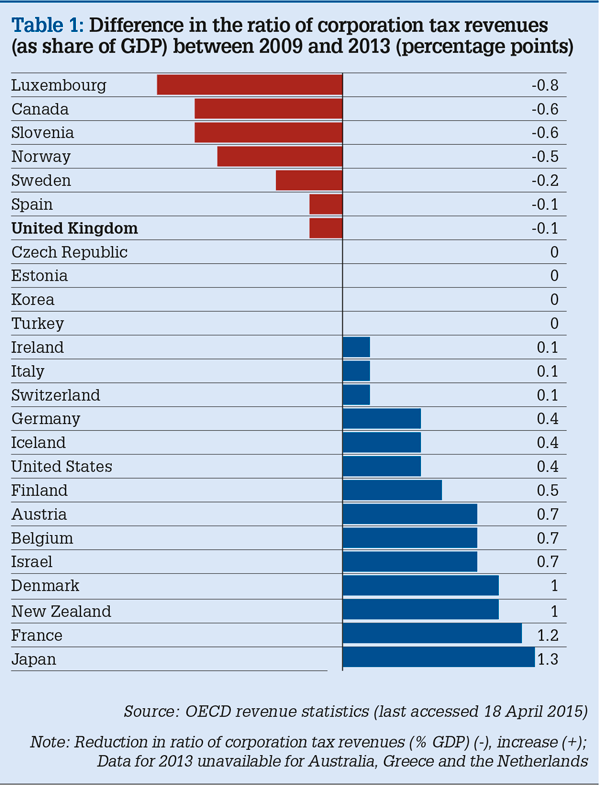
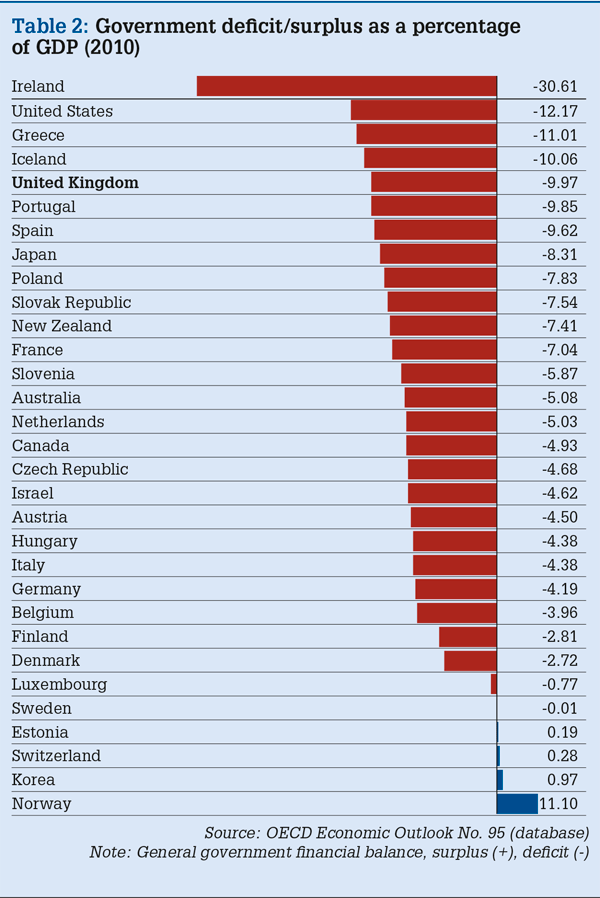
As of 2015, the main statutory corporation tax rate has been cut from 28% to 20%. This is the (equal) lowest corporation tax rate in the G20 (table 3). The small profits rate was cut from 21% to 20% in 2011; therefore, in 2015/16 there will be a single statutory rate of 20%, if after the election the new government confirms the changes introduced by the coalition.
Rate cuts have been partially compensated for by reducing writing down allowances for the main pool of plant and machinery from 20% to 18% and for the small pool from 10% to 8%. Additionally, the government did not repeal the Labour government’s decision to phase out allowances for industrial buildings by 2011.
The value of allowances for small and medium sized enterprises (SMEs) differs markedly, due primarily to the annual investment allowance (AIA). Introduced by the Labour government in 2008, the AIA gives a 100% deduction for expenditure in plant and machinery, with a threshold of investment of £50,000 initially and then of £100,000.
The AIA has two main objectives. First, it reduces the cost of capital (COC) for SMEs; therefore, it should boost investment. It reduces the COC only for businesses with investment below the AIA threshold, so the effect on aggregate investment depends on the size of the threshold: the larger the threshold, the larger the effect. Second, the AIA aims to simplify the capital allowances calculations for SMEs investing below its threshold.
The coalition announced temporary changes to the AIA threshold several times. If the government’s announcement were credible, a temporarily higher threshold may provide an incentive for business to bring investment forward. This is a typical government objective during economic downturns. Nonetheless, frequent and close announcements of temporary increases reduce the credibility of each further announcement.
In its first emergency Budget in June 2010, the coalition announced a cut in the AIA threshold to £25,000, to be implemented after almost two years for expenditures incurred on or after 1 April 2012. However, the AIA threshold was kept at £25,000 for eight months only. It was then raised tenfold, again on a temporary basis, to £250,000, for expenditures incurred on or after 1 January 2013; and it was then doubled – again, on a temporary basis – to £500,000, for expenditures incurred on or after 1 April 2014. In the 2015 Budget, the chancellor announced that the AIA threshold will not be cut back to £25,000. In 2016, however, it will be set at a more generous, but yet unknown rate, were he to stay in government.
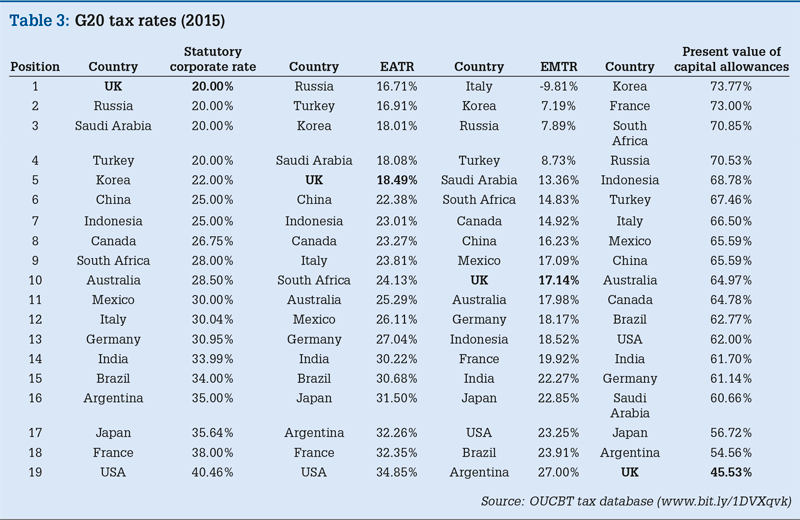
Three measures are used to assess the tax costs associated with corporation tax: the main statutory rate; and two summary measures that account for both the statutory rate and the tax base – the effective average tax rate (EATR) and the effective marginal tax rate (EMTR).
The statutory tax rate affects profit shifting, as the marginal incentive to shift an additional unit of corporate profits after all deductions depends on the corporate statutory tax rate. Figure 1 shows that in 2012, the UK rate dropped below the OECD average; and by 2015, it is about 7.5 percentage points lower. Although the UK rate is consistently below the French and German rates, smaller, low tax OECD jurisdictions have had very attractive rates for profit shifting activities. Such small jurisdictions now become less appealing if compared to the UK corporate tax rate of 20% or to the 10% rate available with the patent box (PB).
Figure 2 shows the evolution of the EATR, which depends on the corporation statutory rate and on capital allowances. It is the proportion of pre-tax profit of a typical investment project that would be taken in tax. It affects the location of investment in the UK, i.e. it affects inward foreign direct investment (FDI). Until 2013, the UK EATR was not particularly competitive compared to the OECD average, although the OECD average includes smaller countries which would not necessarily be competitors of the UK. In 2013, the EATR started declining; and by 2015, the rate is well below the OECD average. Historically, the UK EATR is lower than the French and German rates, with the gap widening substantially since 2011.
If the UK has improved its competitive position substantially in terms of attracting profits and FDI, the EMTR remains relatively high. The EMTR measures the proportionate increase in the cost of capital due to the tax. It accounts for both the statutory rate and for capital allowances. It affects the size of the investment, given the decision to locate in the UK. The EMTR focuses on the margin, i.e. it focuses on a project that just breaks even by earning a return equal to the COC. The tax base, and hence the capital allowances, are very important for the marginal investment project and that is why the UK ranks low on this measure: the UK capital allowances regime is one of the least generous in the OECD. Historically, the UK EMTR has been higher than the OECD average (see figure 3 overleaf). It declined after 2011, but in 2015 it remains well above the OECD average.
The same conclusion can be reached if the UK is compared to the G20 countries (see table 3). The UK has the lowest statutory corporation tax rate, along with Russia, Turkey and Saudi Arabia, but it ranks only fifth for the EATR. It is in only tenth place for the EMTR.


Investment is crucial for the wellbeing of a nation. First, it is a component of GDP and, therefore, higher investment implies higher GDP. Second, investment increases capital stock; and a higher capital stock per worker entails higher productivity and, therefore, higher wages and better living standards. The tax system may affect the magnitude of business investment through two channels. First, a lower tax decreases the COC by reducing the tax burden on the marginal unit of investment. Second, a lower tax implies a smaller liability and therefore a higher net cash flow. Companies that are unable to raise external finance, or that are able to do so only at a prohibitively high cost, may use the tax saving to undertake additional investment.
At the beginning of the coalition term in 2010, investment and FDI were considerably lower than their pre-crisis peak (see figure 4). There is little doubt about the need to stimulate investment at that time.
According to estimates in the economic literature (see ‘FDI and taxation: a meta-study’ (L. P. Feld and J. H. Heckemeyer), Journal of Economic Surveys (2011), 25(2), 233–272), the cut in the UK EATR from 26% to 18% could have increased inbound FDI by 12.5%; and the reduction in the EMTR from 22% to 17% could have increased capital stock by about 2%. This does not necessarily mean that FDI and capital stock have increased. It could also be that they decreased, but less than they would have without the reform. Although there is uncertainty in these estimates, economic evidence points to large effects of tax cuts on FDI and capital stock. These are the benefits of reducing the tax burden.
The assessment of the effect of the AIA is different. The AIA only affects the COC of companies with investment below its threshold. These are likely to be smaller companies, generally with fewer than 100 employees, and these companies only account for about 20% of aggregate investment. Hence, the AIA is unlikely to have had a large effect on aggregate investment and capital stock.
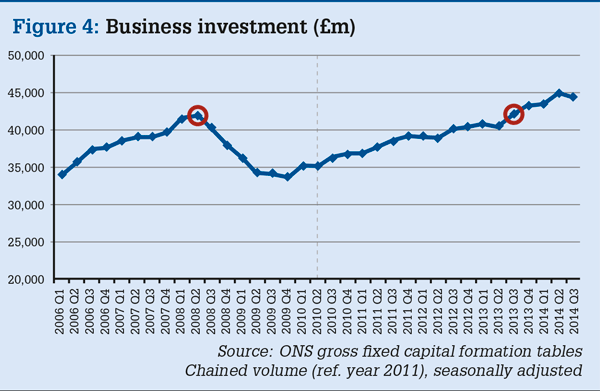
There are some very important elements of the UK tax system, such as the controlled foreign corporation (CFC) regime, the PB and the research and development (R&D) tax incentives, which are not reflected in the statutory rate, the EATR or the EMTR. Such elements will only affect some firms, mostly multinationals; changes in the statutory rate and in general capital allowances, however, will affect all corporations.
The old UK CFC rules were deemed not in line with business practices. The coalition continued Labour’s plan to reform them and delivered the final regime. Despite being controversial, some of its provisions create a competitive advantage to locating a headquarters company in the UK; they certainly lower the COC for UK multinationals, for example, by facilitating the financing of the group through low tax subsidiaries. In particular, the finance company exemption provides that only a quarter of the profits earned by a CFC from loans to overseas companies is taxable at the main UK corporate income tax rate; this implies an effective rate of 5% in 2015.
The PB entered into force on 1 April 2013. It provides that corporate profits from patents held by a UK resident company are taxed at a reduced rate of 10%. In principle, the PB should boost innovation by decreasing the tax cost for the additional unit of investment in R&D or innovation. The PB only targets the income of successful projects.
Accounting for the uncertainty typical of new R&D projects, therefore, it seems poorly targeted at promoting additional innovation activities. The scheme is probably more valuable in retaining or attracting very mobile income (see ‘Intellectual property box regimes: effective tax rates and tax policy considerations’ (Evers, L. Miller, H. and Spengel C), International Tax and Public Finance, 2014, 1–29, at www.bit.ly/1IPJDuO).
The PB was welcomed by business but some countries, particularly Germany, raised concerns that the UK version of the PB could be used as a tool to shift profits out of their high tax jurisdictions. Two elements of the UK PB are particularly competitive and, therefore, controversial. First, patents created elsewhere could have been easily shifted to a UK company so as to enjoy the PB relief. A UK company needs to own and manage the patents, but the research and commercialisation can be carried out in other countries. This may be seen to be in contrast with the UK’s strong support for the OECD BEPS project. Second, eligible income is defined broadly to include all income from a good or service incorporating a patented element.
In November 2014, after an agreement with Germany, the UK accepted to reform its PB regime in line with the modified nexus approach (MNA), which requires that substantial R&D and patent development activity is undertaken in the jurisdiction offering the PB relief (see the Oxford University Centre for Business Taxation report Business taxation under the coalition government, February 2015 (‘2015 OUCBT report’) available at www.bit.ly/1JjM8J0). Legislation regulating the new regime will be implemented by the new government and its attractiveness for mobile, intangible assets and profits will depend on the details of the law, especially on the rules on tracking, tracing and reporting expenditures related to the patent. It will also depend on changes to the PB regimes of other countries, which will all have to be compliant with the MNA, and also on whether new jurisdictions will implement PB regimes. For example, Ireland has announced the intention to bring in a ‘knowledge development box’ in a year’s time and Italy has just introduced a PB.
The coalition has also expanded the generosity of R&D tax incentives for both SMEs and larger companies. It has simplified the system and made it more salient for larger companies by transforming R&D deductions into a credit (the so-called ‘above the line credit’). R&D tax incentives seem more targeted than the PB to increase R&D and innovation activities (see ‘Intellectual property box regimes: effective tax rates and tax policy considerations’ refrred to above) and there is evidence that they increase R&D activities (see the 2015 OUCBT report, referred to above).
Such a comprehensive reform of business taxation implies large costs. In terms of foregone revenues, the reform will cost £7.5bn a year by 2015/16 (or 21% of average annual corporate income revenues). Adding the initial version of the PB brings annual costs to £8.2bn (or 23% of annual corporate income tax revenues). By any standards, these are large costs which will translate into a higher deficit and lower public spending, or they will need to be financed by other taxes, such as VAT. Figure 5 shows that VAT revenues (as a share of total tax revenues) have increased under the coalition, after the standard rate of VAT was raised from 17.5% to 20% in 2011. Revenues from other taxes remained stable or declined, with the exception of a small increase in stamp duties.
The coalition has also introduced new taxes, in particular on the banking sector. The 2010 Budget introduced a bank levy, applied to banks’ total liabilities. The rate initially proposed was 0.07%, which was expected to raise £2bn in revenue in 2010; the rate was to be reduced to 0.04% in 2011. However, in February 2011, the coalition government decided to raise the rate in order to meet a target of £2.5bn. The rates of the levy changed several times before and as part of the 2011 Budget. The rates were gradually increased further to 0.21% for short term liabilities and 0.105% for long term liabilities for 2015.
In the 2014 Autumn Statement, the government introduced a restriction on the amount of banks’ profits that can be offset by carried forward losses. From fiscal year 2015, only up to 50% of taxable profits may be offset by loss carry forwards.
Before the crisis, the financial industry contributed between 21% and 26% of net corporate tax receipts. From 2008/09 onwards, its contribution declined to between 11% and 16%. Figure 6 shows that even accounting for the bank levy receipts, the contribution of the financial sector remains well below its pre-crisis level.
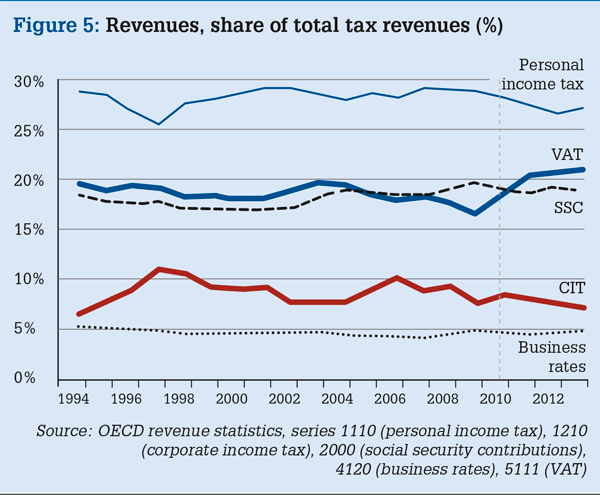
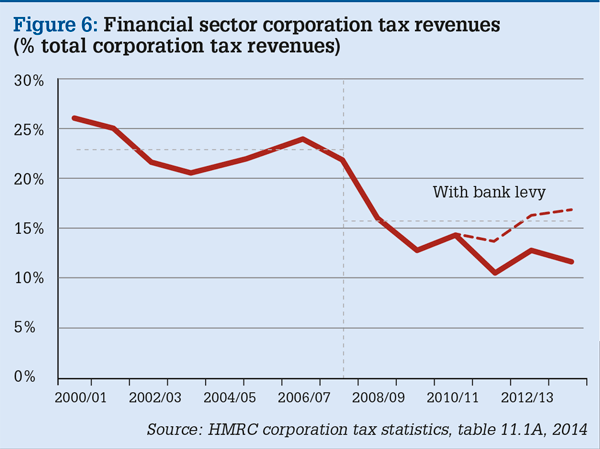
The competitive position of the UK with respect to the OECD has improved substantially since 2011. By 2015, the main corporate statutory tax rate and the EATR are well beneath the OECD average. This suggests that, for the location of profits and of FDI, the UK has become very attractive.
The government has failed to make the tax component of the user cost of capital (EMTR) particularly competitive, though. The UK EMTR has historically been higher than the OECD average and this has not changed under the coalition. For large companies, the UK capital allowances regime remains one of the least generous in the OECD. This affects firms’ COC negatively and therefore reduces their incentive to expand investment in physical assets. It is difficult to reconcile a regime of low capital allowances with the coalition’s ambition of protecting the manufacturing sector.
Although relatively less attractive for industries with large investment in plant, machinery and buildings, today’s UK tax system is very attractive for the location of headquarter companies and more generally for the location of activities of multinational companies. There are seven main reasons.
Was it a good idea to make the tax system competitive? Business investment has dropped substantially during the economic crisis (see figure 4) and, according to the latest data released by the ONS, UK labour productivity has been stagnating since 2007. In this context, it is hard to argue against a strong support for investment and innovation, also through the tax system. Academic literature over at least 30 years shows that large corporate tax cuts can foster investment and capital stock substantially (see ‘FDI and taxation: a meta-study’ (Feld and Heckermeyer) referred to above).
There are costs, though. How should we think about them? Competition drives down corporation tax revenues, so that other taxes have to rise to compensate for the foregone revenue (or public spending has to shrink). Are changes in the composition of tax revenues and in the structure of the tax system necessarily problematic?
On efficiency, the literature generally points to corporation tax as being one of the least efficient taxes, while taxes on consumption, land and immovable property are thought to be more efficient. Empirical evidence shows that an increase in recurrent property and land taxes or in taxes on consumption could generate an increase in the GDP growth, if accompanied by a reduction of the taxation of labour and profits. A change from income to property taxes generates a more positive effect than for a shift from income to consumption taxes, and would also have the benefit of better distributional properties (‘Tax policy for economic recovery and growth’ (Jens Matthias Arnold, Bert Brys, Christopher Heady, Åsa Johansson, Cyrille Schwellnus and Laura Vartia), Economic Journal (2011) 121, 59–80). A change in the tax mix could therefore increase the efficiency of the system.
On fairness, the question of the fairness of the corporation tax has been the subject of much debate in the academic literature, and is still unresolved. Much of the literature points to a large part of corporation tax being passed on in lower wages, although there are mixed results on that. There are, though, no serious studies that have been able to identify whether corporation tax is progressive or regressive. There is therefore no evidence that reducing the corporate income tax exacerbates inequalities of income. Because its real incidence is uncertain, the corporate income tax is not the right tool for addressing redistribution. The main tools for redistribution remain personal income tax, inheritance tax and possibly recurrent taxes on property.
With elections looming, the question is what the new government will do. The Labour Party announced that it will not cut the 2015 corporate rate to 20% but it will maintain it at 21%. The difference is minimal and this reflects the current consensus for a rate of around 20%. More generally, many measures introduced by the coalition had already been proposed by the previous Labour government, which has not really opposed the coalition’s competitiveness agenda. This reflects a broad consensus on the fact that competitiveness is a key tool for UK growth. The opposition has instead come from some countries, particularly Germany, which are concerned about the possible erosion of their tax base through measures such as the PB.
In this context, one of the challenges of the new government will be to combine its support for the OECD BEPS project with a competitiveness agenda aimed at fostering UK investment, productivity and, ultimately, living standards. Further reductions of the tax burden would be possible; for example, through an increase in capital allowances, a feature where the UK tax system is not particularly competitive, at least partially financed with less distortive taxes such as for example recurrent taxes on property. Nonetheless, there is currently little discussion about changing the composition of the tax burden substantially. With a business tax regime that is for now competitive and a deficit which is still large, the priority will probably be to improve public finances.
The coalition’s extensive reforms succeeded in making the UK attractive for foreign direct investment and mobile profits. However, when judged according to a key indicator, the effective marginal tax rate, which affects the size of investment, the UK is not particularly competitive. Other reforms have increased competitiveness, including an increase in R&D tax incentives, the introduction of the patent box, and a relaxation in the CFC rules. The cost of the reforms in terms of foregone revenues is large, around £7.5bn in 2015/16, equivalent to 21% of corporation tax revenue. Empirical evidence shows, though, that large corporate tax cuts foster investment and capital stock substantially.
Giorgia Maffini (Oxford University Centre for Business Taxation at Saïd Business School) reviews the coalition’s extensive reforms for making the UK attractive for foreign direct investment and mobile profits, and illustrates to what extent these have succeeded
Over the last 30 years, governments across  the OECD have gradually cut statutory rates of corporation tax to attract mobile activities and profits (figure 1). This trend had slowed by 2010. At the height of the financial crisis, governments were struggling to reduce their budget deficits. There was little room for tax cuts and most OECD countries decided to avoid large tax reductions. Between 2009 and 2013, the tax burden on corporations, measured as corporate tax revenues as a share of GDP, increased or remained stable in most OECD countries (table 1).
the OECD have gradually cut statutory rates of corporation tax to attract mobile activities and profits (figure 1). This trend had slowed by 2010. At the height of the financial crisis, governments were struggling to reduce their budget deficits. There was little room for tax cuts and most OECD countries decided to avoid large tax reductions. Between 2009 and 2013, the tax burden on corporations, measured as corporate tax revenues as a share of GDP, increased or remained stable in most OECD countries (table 1).
Despite having inherited one of the largest deficits in the OECD (table 2), the coalition had a very different plan. The goal was ambitious:
‘Our aim is to create the most competitive corporate tax regime in the G20, while protecting manufacturing industries.’ (The coalition agreement, May 2010.)
Over five years, the government unrolled an intense reform programme, which would substantially reduce the tax burden on firms and make the UK business tax regime considerably more attractive.


As of 2015, the main statutory corporation tax rate has been cut from 28% to 20%. This is the (equal) lowest corporation tax rate in the G20 (table 3). The small profits rate was cut from 21% to 20% in 2011; therefore, in 2015/16 there will be a single statutory rate of 20%, if after the election the new government confirms the changes introduced by the coalition.
Rate cuts have been partially compensated for by reducing writing down allowances for the main pool of plant and machinery from 20% to 18% and for the small pool from 10% to 8%. Additionally, the government did not repeal the Labour government’s decision to phase out allowances for industrial buildings by 2011.
The value of allowances for small and medium sized enterprises (SMEs) differs markedly, due primarily to the annual investment allowance (AIA). Introduced by the Labour government in 2008, the AIA gives a 100% deduction for expenditure in plant and machinery, with a threshold of investment of £50,000 initially and then of £100,000.
The AIA has two main objectives. First, it reduces the cost of capital (COC) for SMEs; therefore, it should boost investment. It reduces the COC only for businesses with investment below the AIA threshold, so the effect on aggregate investment depends on the size of the threshold: the larger the threshold, the larger the effect. Second, the AIA aims to simplify the capital allowances calculations for SMEs investing below its threshold.
The coalition announced temporary changes to the AIA threshold several times. If the government’s announcement were credible, a temporarily higher threshold may provide an incentive for business to bring investment forward. This is a typical government objective during economic downturns. Nonetheless, frequent and close announcements of temporary increases reduce the credibility of each further announcement.
In its first emergency Budget in June 2010, the coalition announced a cut in the AIA threshold to £25,000, to be implemented after almost two years for expenditures incurred on or after 1 April 2012. However, the AIA threshold was kept at £25,000 for eight months only. It was then raised tenfold, again on a temporary basis, to £250,000, for expenditures incurred on or after 1 January 2013; and it was then doubled – again, on a temporary basis – to £500,000, for expenditures incurred on or after 1 April 2014. In the 2015 Budget, the chancellor announced that the AIA threshold will not be cut back to £25,000. In 2016, however, it will be set at a more generous, but yet unknown rate, were he to stay in government.

Three measures are used to assess the tax costs associated with corporation tax: the main statutory rate; and two summary measures that account for both the statutory rate and the tax base – the effective average tax rate (EATR) and the effective marginal tax rate (EMTR).
The statutory tax rate affects profit shifting, as the marginal incentive to shift an additional unit of corporate profits after all deductions depends on the corporate statutory tax rate. Figure 1 shows that in 2012, the UK rate dropped below the OECD average; and by 2015, it is about 7.5 percentage points lower. Although the UK rate is consistently below the French and German rates, smaller, low tax OECD jurisdictions have had very attractive rates for profit shifting activities. Such small jurisdictions now become less appealing if compared to the UK corporate tax rate of 20% or to the 10% rate available with the patent box (PB).
Figure 2 shows the evolution of the EATR, which depends on the corporation statutory rate and on capital allowances. It is the proportion of pre-tax profit of a typical investment project that would be taken in tax. It affects the location of investment in the UK, i.e. it affects inward foreign direct investment (FDI). Until 2013, the UK EATR was not particularly competitive compared to the OECD average, although the OECD average includes smaller countries which would not necessarily be competitors of the UK. In 2013, the EATR started declining; and by 2015, the rate is well below the OECD average. Historically, the UK EATR is lower than the French and German rates, with the gap widening substantially since 2011.
If the UK has improved its competitive position substantially in terms of attracting profits and FDI, the EMTR remains relatively high. The EMTR measures the proportionate increase in the cost of capital due to the tax. It accounts for both the statutory rate and for capital allowances. It affects the size of the investment, given the decision to locate in the UK. The EMTR focuses on the margin, i.e. it focuses on a project that just breaks even by earning a return equal to the COC. The tax base, and hence the capital allowances, are very important for the marginal investment project and that is why the UK ranks low on this measure: the UK capital allowances regime is one of the least generous in the OECD. Historically, the UK EMTR has been higher than the OECD average (see figure 3 overleaf). It declined after 2011, but in 2015 it remains well above the OECD average.
The same conclusion can be reached if the UK is compared to the G20 countries (see table 3). The UK has the lowest statutory corporation tax rate, along with Russia, Turkey and Saudi Arabia, but it ranks only fifth for the EATR. It is in only tenth place for the EMTR.


Investment is crucial for the wellbeing of a nation. First, it is a component of GDP and, therefore, higher investment implies higher GDP. Second, investment increases capital stock; and a higher capital stock per worker entails higher productivity and, therefore, higher wages and better living standards. The tax system may affect the magnitude of business investment through two channels. First, a lower tax decreases the COC by reducing the tax burden on the marginal unit of investment. Second, a lower tax implies a smaller liability and therefore a higher net cash flow. Companies that are unable to raise external finance, or that are able to do so only at a prohibitively high cost, may use the tax saving to undertake additional investment.
At the beginning of the coalition term in 2010, investment and FDI were considerably lower than their pre-crisis peak (see figure 4). There is little doubt about the need to stimulate investment at that time.
According to estimates in the economic literature (see ‘FDI and taxation: a meta-study’ (L. P. Feld and J. H. Heckemeyer), Journal of Economic Surveys (2011), 25(2), 233–272), the cut in the UK EATR from 26% to 18% could have increased inbound FDI by 12.5%; and the reduction in the EMTR from 22% to 17% could have increased capital stock by about 2%. This does not necessarily mean that FDI and capital stock have increased. It could also be that they decreased, but less than they would have without the reform. Although there is uncertainty in these estimates, economic evidence points to large effects of tax cuts on FDI and capital stock. These are the benefits of reducing the tax burden.
The assessment of the effect of the AIA is different. The AIA only affects the COC of companies with investment below its threshold. These are likely to be smaller companies, generally with fewer than 100 employees, and these companies only account for about 20% of aggregate investment. Hence, the AIA is unlikely to have had a large effect on aggregate investment and capital stock.

There are some very important elements of the UK tax system, such as the controlled foreign corporation (CFC) regime, the PB and the research and development (R&D) tax incentives, which are not reflected in the statutory rate, the EATR or the EMTR. Such elements will only affect some firms, mostly multinationals; changes in the statutory rate and in general capital allowances, however, will affect all corporations.
The old UK CFC rules were deemed not in line with business practices. The coalition continued Labour’s plan to reform them and delivered the final regime. Despite being controversial, some of its provisions create a competitive advantage to locating a headquarters company in the UK; they certainly lower the COC for UK multinationals, for example, by facilitating the financing of the group through low tax subsidiaries. In particular, the finance company exemption provides that only a quarter of the profits earned by a CFC from loans to overseas companies is taxable at the main UK corporate income tax rate; this implies an effective rate of 5% in 2015.
The PB entered into force on 1 April 2013. It provides that corporate profits from patents held by a UK resident company are taxed at a reduced rate of 10%. In principle, the PB should boost innovation by decreasing the tax cost for the additional unit of investment in R&D or innovation. The PB only targets the income of successful projects.
Accounting for the uncertainty typical of new R&D projects, therefore, it seems poorly targeted at promoting additional innovation activities. The scheme is probably more valuable in retaining or attracting very mobile income (see ‘Intellectual property box regimes: effective tax rates and tax policy considerations’ (Evers, L. Miller, H. and Spengel C), International Tax and Public Finance, 2014, 1–29, at www.bit.ly/1IPJDuO).
The PB was welcomed by business but some countries, particularly Germany, raised concerns that the UK version of the PB could be used as a tool to shift profits out of their high tax jurisdictions. Two elements of the UK PB are particularly competitive and, therefore, controversial. First, patents created elsewhere could have been easily shifted to a UK company so as to enjoy the PB relief. A UK company needs to own and manage the patents, but the research and commercialisation can be carried out in other countries. This may be seen to be in contrast with the UK’s strong support for the OECD BEPS project. Second, eligible income is defined broadly to include all income from a good or service incorporating a patented element.
In November 2014, after an agreement with Germany, the UK accepted to reform its PB regime in line with the modified nexus approach (MNA), which requires that substantial R&D and patent development activity is undertaken in the jurisdiction offering the PB relief (see the Oxford University Centre for Business Taxation report Business taxation under the coalition government, February 2015 (‘2015 OUCBT report’) available at www.bit.ly/1JjM8J0). Legislation regulating the new regime will be implemented by the new government and its attractiveness for mobile, intangible assets and profits will depend on the details of the law, especially on the rules on tracking, tracing and reporting expenditures related to the patent. It will also depend on changes to the PB regimes of other countries, which will all have to be compliant with the MNA, and also on whether new jurisdictions will implement PB regimes. For example, Ireland has announced the intention to bring in a ‘knowledge development box’ in a year’s time and Italy has just introduced a PB.
The coalition has also expanded the generosity of R&D tax incentives for both SMEs and larger companies. It has simplified the system and made it more salient for larger companies by transforming R&D deductions into a credit (the so-called ‘above the line credit’). R&D tax incentives seem more targeted than the PB to increase R&D and innovation activities (see ‘Intellectual property box regimes: effective tax rates and tax policy considerations’ refrred to above) and there is evidence that they increase R&D activities (see the 2015 OUCBT report, referred to above).
Such a comprehensive reform of business taxation implies large costs. In terms of foregone revenues, the reform will cost £7.5bn a year by 2015/16 (or 21% of average annual corporate income revenues). Adding the initial version of the PB brings annual costs to £8.2bn (or 23% of annual corporate income tax revenues). By any standards, these are large costs which will translate into a higher deficit and lower public spending, or they will need to be financed by other taxes, such as VAT. Figure 5 shows that VAT revenues (as a share of total tax revenues) have increased under the coalition, after the standard rate of VAT was raised from 17.5% to 20% in 2011. Revenues from other taxes remained stable or declined, with the exception of a small increase in stamp duties.
The coalition has also introduced new taxes, in particular on the banking sector. The 2010 Budget introduced a bank levy, applied to banks’ total liabilities. The rate initially proposed was 0.07%, which was expected to raise £2bn in revenue in 2010; the rate was to be reduced to 0.04% in 2011. However, in February 2011, the coalition government decided to raise the rate in order to meet a target of £2.5bn. The rates of the levy changed several times before and as part of the 2011 Budget. The rates were gradually increased further to 0.21% for short term liabilities and 0.105% for long term liabilities for 2015.
In the 2014 Autumn Statement, the government introduced a restriction on the amount of banks’ profits that can be offset by carried forward losses. From fiscal year 2015, only up to 50% of taxable profits may be offset by loss carry forwards.
Before the crisis, the financial industry contributed between 21% and 26% of net corporate tax receipts. From 2008/09 onwards, its contribution declined to between 11% and 16%. Figure 6 shows that even accounting for the bank levy receipts, the contribution of the financial sector remains well below its pre-crisis level.


The competitive position of the UK with respect to the OECD has improved substantially since 2011. By 2015, the main corporate statutory tax rate and the EATR are well beneath the OECD average. This suggests that, for the location of profits and of FDI, the UK has become very attractive.
The government has failed to make the tax component of the user cost of capital (EMTR) particularly competitive, though. The UK EMTR has historically been higher than the OECD average and this has not changed under the coalition. For large companies, the UK capital allowances regime remains one of the least generous in the OECD. This affects firms’ COC negatively and therefore reduces their incentive to expand investment in physical assets. It is difficult to reconcile a regime of low capital allowances with the coalition’s ambition of protecting the manufacturing sector.
Although relatively less attractive for industries with large investment in plant, machinery and buildings, today’s UK tax system is very attractive for the location of headquarter companies and more generally for the location of activities of multinational companies. There are seven main reasons.
Was it a good idea to make the tax system competitive? Business investment has dropped substantially during the economic crisis (see figure 4) and, according to the latest data released by the ONS, UK labour productivity has been stagnating since 2007. In this context, it is hard to argue against a strong support for investment and innovation, also through the tax system. Academic literature over at least 30 years shows that large corporate tax cuts can foster investment and capital stock substantially (see ‘FDI and taxation: a meta-study’ (Feld and Heckermeyer) referred to above).
There are costs, though. How should we think about them? Competition drives down corporation tax revenues, so that other taxes have to rise to compensate for the foregone revenue (or public spending has to shrink). Are changes in the composition of tax revenues and in the structure of the tax system necessarily problematic?
On efficiency, the literature generally points to corporation tax as being one of the least efficient taxes, while taxes on consumption, land and immovable property are thought to be more efficient. Empirical evidence shows that an increase in recurrent property and land taxes or in taxes on consumption could generate an increase in the GDP growth, if accompanied by a reduction of the taxation of labour and profits. A change from income to property taxes generates a more positive effect than for a shift from income to consumption taxes, and would also have the benefit of better distributional properties (‘Tax policy for economic recovery and growth’ (Jens Matthias Arnold, Bert Brys, Christopher Heady, Åsa Johansson, Cyrille Schwellnus and Laura Vartia), Economic Journal (2011) 121, 59–80). A change in the tax mix could therefore increase the efficiency of the system.
On fairness, the question of the fairness of the corporation tax has been the subject of much debate in the academic literature, and is still unresolved. Much of the literature points to a large part of corporation tax being passed on in lower wages, although there are mixed results on that. There are, though, no serious studies that have been able to identify whether corporation tax is progressive or regressive. There is therefore no evidence that reducing the corporate income tax exacerbates inequalities of income. Because its real incidence is uncertain, the corporate income tax is not the right tool for addressing redistribution. The main tools for redistribution remain personal income tax, inheritance tax and possibly recurrent taxes on property.
With elections looming, the question is what the new government will do. The Labour Party announced that it will not cut the 2015 corporate rate to 20% but it will maintain it at 21%. The difference is minimal and this reflects the current consensus for a rate of around 20%. More generally, many measures introduced by the coalition had already been proposed by the previous Labour government, which has not really opposed the coalition’s competitiveness agenda. This reflects a broad consensus on the fact that competitiveness is a key tool for UK growth. The opposition has instead come from some countries, particularly Germany, which are concerned about the possible erosion of their tax base through measures such as the PB.
In this context, one of the challenges of the new government will be to combine its support for the OECD BEPS project with a competitiveness agenda aimed at fostering UK investment, productivity and, ultimately, living standards. Further reductions of the tax burden would be possible; for example, through an increase in capital allowances, a feature where the UK tax system is not particularly competitive, at least partially financed with less distortive taxes such as for example recurrent taxes on property. Nonetheless, there is currently little discussion about changing the composition of the tax burden substantially. With a business tax regime that is for now competitive and a deficit which is still large, the priority will probably be to improve public finances.







